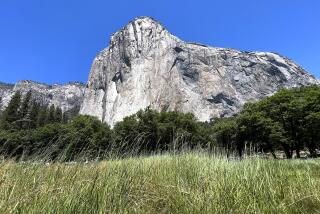Forest Service Issues Moratorium on Logging Roads
- Share via
As part of a Clinton administration plan to reduce environmental damage in national forests, the U.S. Forest Service on Thursday declared an 18-month halt to the construction of logging roads across 33 million acres of forest land.
The moratorium on roads in areas that currently have none will be in effect while a final policy is worked out. It covers 14 of the 18 national forests in California and roughly one-sixth of the 191 million acres of timberland in the federal forest system, mostly in the West.
Four forests in the northwestern corner of California are among 26 nationwide excluded from the road building ban. Federal officials say that most of those forests are already covered by management plans designed to preserve endangered species. Forest Service officials said there are no immediate plans for new logging operations in regions with no roads in any of the four California forests.
Announcing the plan at a Washington news conference, Agriculture Secretary Dan Glickman, whose department includes the Forest Service, described the moratorium “as an official timeout” while the service brings its management more in tune with forest needs and uses.
“There are 383,000 miles of forest roads already in existence, enough to circle the globe many times,” Glickman said. “Less than half of them meet minimum environmental and safety standards,” he said, estimating the total repair cost at more than $8 billion.
Glickman said that close to 2 million vehicles traverse forest roads every day, “many of them station wagons with families.”
Forest Service officials said that the impact on logging operations would be negligible, estimating that the moratorium would reduce the annual amount of timber cut in national forests by only to 2% to 3%.
Industry officials bitterly criticized the ban. In a statement, the American Forest & Paper Assn. described the moratorium as a disaster, contending that it will penalize all users of the roads and not just the timber industry.
“The ban on forest road construction is a red herring devised by those who are determined to shut down access to our forests at any cost,” said W. Henson Moore, president of the association.
But the national forests can no longer be regarded mainly as “the nation’s wood basket,” said Agriculture Undersecretary Jim Lyons. “The forests are a primary source of clean water. They offer refuge for fish and wildlife and they are, increasingly, the nation’s playground.
“We are going from an old-fashioned system of logging roads to a modern transportation system vital to the commerce of rural communities,” Lyons said. “We need to make careful calculations as to which roads need to be maintained and which should be abandoned for the good of the environment.”
Some forest roads and the traffic they carry disrupt wildlife corridors crucial to the survival of bighorn sheep and grizzly bears. Bulldozed into steep slopes above mountain streams, unstable logging roads have also contributed substantially to the erosion that has degraded water quality and destroyed fisheries.
But Lyons said that the government action should not be read as a signal that all 33 million acres will remain off limits to new roads after the moratorium is over.
“We need to make careful calculations as to where new roads should be built and where the land should be off limits to roads.”
Environmental groups, which have been campaigning strenuously to keep logging operations out of areas with no roads, responded with measured enthusiasm to the moratorium.
“We’re happy to see the administration begin to pay attention to the public’s call for more wilderness protection,” said Paul Stitler of the California Wilderness Coalition. “But it is simply inadequate to partially protect some roadless areas. In California, they are leaving out the forests that have lost the most roadless area in the last 20 years.”
Those forests are the Klamath, Shasta-Trinity, Six Rivers and Mendocino.
The Wilderness Society also applauded the moratorium but said that it left unprotected about 15 million acres of areas with no roads, in particular large parts of Alaska’s Tongass National Forest, the nation’s largest intact temperate rain forest.
More to Read
Sign up for Essential California
The most important California stories and recommendations in your inbox every morning.
You may occasionally receive promotional content from the Los Angeles Times.













